Study on Recycling of Steel Slags Used as Coarse and Fine Aggregates in Induction Healing Asphalt Concretes
Abstract
:1. Introduction
2. Materials and Experiments
2.1. Materials
2.2. Specimen Preparation
2.3. Moisture Susceptibility Test
2.4. High-Temperature Deformation Resistance Test
2.5. Semi-Circle Bending Fracture Test
2.6. Thermal Properties Test
2.7. Induction Heating Speed and Natural Cooling Speed Test
2.8. Induction-Healing Property Test
- R: Healing Rate, %
- F1: Initial Breaking Strength, kN;
- F2: Terminal Breaking Strength, kN.
3. Results and Discussion
3.1. Surface Texture and Pore Sizes Analysis
3.2. Moisture Susceptibility Analysis
3.3. High-Temperature Deformation Resistance
3.4. Semi-Circle Bending Fracture Test
3.5. Thermal Properties
3.6. Heating and Cooling Speed
3.7. Induction-Healing Property
3.8. CT Scanning
4. Conclusions
- (1)
- Steel slag contains more pores on the surface while basalt shows plate-like structure and dense surface, and steel slag possesses more pores in volume, which causes the asphalt concrete with basalt aggregate replaced by steel slag holds better heating storage capacity.
- (2)
- Steel fibers contribute to increasing the resistance to moisture damage, high temperature deformation resistance and mechanical performance, while steel slag is beneficial to high temperature deformation resistance, mechanical performance but negative to the resistance to moisture damage due to the presence of f-CaO.
- (3)
- With replacement of steel slag, the asphalt concrete has normal heating time and longer cooling time. More time is provided to heal for the steel slag induction of healing asphalt concretes.
- (4)
- Healing in steel slag induction heating asphalt concrete is successful, and with steel fibers content decreasing, healing of steel slag induction healing asphalt concrete increases. Furthermore, healing is similar between steel slag and basalt induction healing asphalt concretes.
- (5)
- With the same asphalt aggregate ratio, steel slag asphalt concrete shows similar moisture susceptibility, better high-temperature deform resistance, identical induction healing property to basalt asphalt concrete, which means that asphalt concrete using steel slag can work as well as asphalt concrete using basalt without more asphalt added, and the cost of more asphalt can be decreased.
- (6)
- Overall, it is concluded that steel slag can apply in induction heating asphalt concretes to replace coarse and fine aggregates.
Author Contributions
Funding
Conflicts of Interest
References
- Chen, Z.; Wu, S.; Xiao, Y.; Zeng, W.; Yi, M.; Wan, J. Effect of hydration and silicone resin on Basic Oxygen Furnace slag and its asphalt mixture. J. Clean. Prod. 2016, 112, 392–400. [Google Scholar] [CrossRef]
- Huang, Y.; Bird, R.N.; Heidrich, O. A review of the use of recycled solid waste materials in asphalt pavements. Resour. Conserv. Recycl. 2007, 52, 58–73. [Google Scholar] [CrossRef]
- Chen, Z.; Wu, S.; Wen, J.; Zhao, M.; Yi, M.; Wan, J. Utilization of gneiss coarse aggregate and steel slag fine aggregate in asphalt mixture. Constr. Build. Mater. 2015, 93, 911–918. [Google Scholar] [CrossRef]
- Yang, L.Y.; Tan, Y.Q.; Liu, H.; Dong, Y.M. Evaluation of hma with coal gangue coarse aggregate. Adv. Mater. Res. 2011, 199–200, 209–215. [Google Scholar] [CrossRef]
- Zhao, M.; Wu, S.; Chen, Z.; Li, C. Production and application of steel slag coarse aggregate in asphalt mixture. Emerg. Mater. Res. 2017, 6, 219–222. [Google Scholar] [CrossRef]
- Gao, J.; Sha, A.; Wang, Z.; Tong, Z.; Liu, Z. Utilization of steel slag as aggregate in asphalt mixtures for microwave deicing. J. Clean. Prod. 2017, 152, 429–442. [Google Scholar] [CrossRef]
- Liu, Q.; Li, B.; Schlangen, E.; Sun, Y.; Wu, S. Research on the Mechanical, Thermal, Induction Heating and Healing Properties of Steel Slag/Steel Fibers Composite Asphalt Mixture. Appl. Sci. 2017, 7, 1088. [Google Scholar] [CrossRef] [Green Version]
- Ge, D.; You, Z.; Chen, S.; Liu, C.; Gao, J.; Lv, S. The performance of asphalt binder with trichloroethylene: Improving the efficiency of using reclaimed asphalt pavement. J. Clean. Prod. 2019, 232, 205–212. [Google Scholar] [CrossRef]
- Ullah, S.; Tanyu, B.F. Methodology to develop design guidelines to construct unbound base course with reclaimed asphalt pavement (RAP). Constr. Build. Mater. 2019, 223, 463–476. [Google Scholar] [CrossRef]
- Shen, D.-H.; Wu, C.-M.; Du, J.-C. Laboratory investigation of basic oxygen furnace slag for substitution of aggregate in porous asphalt mixture. Constr. Build. Mater. 2009, 23, 453–461. [Google Scholar] [CrossRef]
- Reddy, A.S.; Pradhan, R.K.; Chandra, S. Utilization of Basic Oxygen Furnace (BOF) slag in the production of a hydraulic cement binder. Int. J. Miner. Process. 2006, 79, 98–105. [Google Scholar] [CrossRef]
- Huang, Y.; Xu, G.; Cheng, H.; Wang, J.; Wan, Y.; Chen, H. An Overview of Utilization of Steel Slag. Procedia Environ. Sci. 2012, 16, 791–801. [Google Scholar]
- Javier, G.G.; Virgilio, C.; Lorena, R.-V.; Elena, C.-F.; Rafael, G.-M.; Laura, T. Influence of accumulation of heaps of steel slag on the environment: Determination of heavy metals content in the soils. An. Acad. Bras. Cienc. 2010, 82, 267–277. [Google Scholar]
- Zumrawi, M. Experimental Study of Steel Slag Used as Aggregate in Asphalt. Am. J. Constr. Build. Mater. 2017, 2, 26–32. [Google Scholar]
- Bessa, I.S.; Castelo Branco, V.T.F.; Soares, J.B. Evaluation of polishing and degradation resistance of natural aggregates and steel slag using the aggregate image measurement system. Road Mater. Pavement Des. 2014, 15, 385–405. [Google Scholar] [CrossRef]
- Sudo Lutif Teixeira, J.E.; Schumacher, A.G.; Pires, P.M.; Franco Castelo Branco, V.T.; Martins, H.B. Expansion Level of Steel Slag Aggregate Effects on Both Material Properties and Asphalt Mixture Performance. Transp. Res. Rec. 2019, 2673, 506–515. [Google Scholar] [CrossRef]
- Ahmedzade, P.; Sengoz, B. Evaluation of steel slag coarse aggregate in hot mix asphalt concrete. J. Hazard. Mater. 2009, 165, 300–305. [Google Scholar] [CrossRef]
- Wen, H.; Wu, S.; Bhusal, S. Performance Evaluation of Asphalt Mixes Containing Steel Slag Aggregate as a Measure to Resist Studded Tire Wear. J. Mater. Civ. Eng. 2016, 28, 0001475. [Google Scholar] [CrossRef]
- Huang, L.-S. Evaluation of the Cooling and Pavement Performance of Basic Oxygen Furnace Slag Used in Asphalt Mixture. Appl. Sci. 2017, 7, 1226. [Google Scholar] [CrossRef] [Green Version]
- Xiao, Z.; Chen, M.; Wu, S.; Xie, J.; Kong, D.; Qiao, Z.; Niu, C. Moisture Susceptibility Evaluation of Asphalt Mixtures Containing Steel Slag Powder as Filler. Materials 2019, 12, 3211. [Google Scholar] [CrossRef] [Green Version]
- Xue, Y.; Wu, S.; Hou, H.; Zha, J. Experimental investigation of basic oxygen furnace slag used as aggregate in asphalt mixture. J. Hazard. Mater. 2006, 138, 261–268. [Google Scholar] [CrossRef] [PubMed]
- Shen, A.; Liu, B.; Guo, Y.; Yu, P.; Yu, M. Skid Resistance Attenuation of Steel Slag Asphalt Mixtures on Tunnel Pavement. J. Build. Mater. 2019, 22, 284–291. [Google Scholar]
- Kandahl, P.S.; Hoffman, G.L. The Use of Steel Slag As Bituminous Concrete Fine Aggregate. Research project 79-26, Final Report; Pennsylvania Department of Transportation: Harrisburg, PA, USA, 1982.
- Kandahl, P.S.; Hoffman, G.L. Evaluation of steel slag fine aggregate in hot-mix asphalt mixtures. Transp. Res. Rec. 1997, 1583, 28–36. [Google Scholar] [CrossRef]
- Zuo, C.; Birkin, M.; Clarke, G.; McEvoy, F.; Bloodworth, A. Reducing carbon emissions related to the transportation of aggregates: Is road or rail the solution? Transp. Res. Part A Policy Pract. 2018, 117, 26–38. [Google Scholar] [CrossRef] [Green Version]
- Xie, J.; Yang, C.; Zhang, L.; Zhou, X.; Wu, S.; Ye, Q. Investigation of the physic-chemical properties and toxic potential of Basic Oxygen Furnace Slag (BOF) in asphalt pavement constructed after 15 years. Constr. Build. Mater. 2020, 238, 117630. [Google Scholar] [CrossRef]
- Zhu, B.; Chu, L.; Fwa, T.F. Cooling characteristics of warm mix asphalt for multi-lift pavement repair and resurfacing. Int. J. Pavement Eng. 2019. [Google Scholar] [CrossRef]
- García, á.; Schlangen, E.; van de Ven, M.; Liu, Q. A simple model to define induction heating in asphalt mastic. Constr. Build. Mater. 2012, 31, 38–46. [Google Scholar] [CrossRef]
- Garcia, A.; Schlangen, E.; van de Ven, M.; Liu, Q. Electrical conductivity of asphalt mortar containing conductive fibers and fillers. Constr. Build. Mater. 2009, 23, 3175–3181. [Google Scholar] [CrossRef]
- Liu, Q.; Schlangen, E.; van de Ven, M.; Garcia, A. Healing of Porous Asphalt Concrete via Induction Heating. Road Mater. Pavement Des. 2010, 11, 527–542. [Google Scholar] [CrossRef]
- García, A.; Norambuena-Contreras, J.; Partl, M.N. Experimental evaluation of dense asphalt concrete properties for induction heating purposes. Constr. Build. Mater. 2013, 46, 48–54. [Google Scholar] [CrossRef]
- Garcia, A. Self-healing of open cracks in asphalt mastic. Fuel 2012, 93, 264–272. [Google Scholar] [CrossRef]
- García, A.; Norambuena-Contreras, J.; Partl, M.N.; Schuetz, P. Uniformity and mechanical properties of dense asphalt concrete with steel wool fibers. Constr. Build. Mater. 2013, 43, 107–117. [Google Scholar] [CrossRef]
- Apostolidis, P.; Liu, X.; Wang, H.; van de Ven, M.F.C.; Scarpas, A. Induction healing of asphalt mixes with steel slag. In Proceedings of the Advances in Materials and Pavement Prediction TRB: Papers from the International Conference on Advances in Materials and Pavement Performance Prediction, Doha, Qatar, 16–18 April 2018. [Google Scholar]
- Wan, J.; Shaopeng, W.; Yue, X.; Zongwu, C.; Construction, Z.D.J.; Materials, B. Study on the effective composition of steel slag for asphalt mixture induction heating purpose. Constr. Build. Mater. 2018, 178, 542–550. [Google Scholar] [CrossRef]


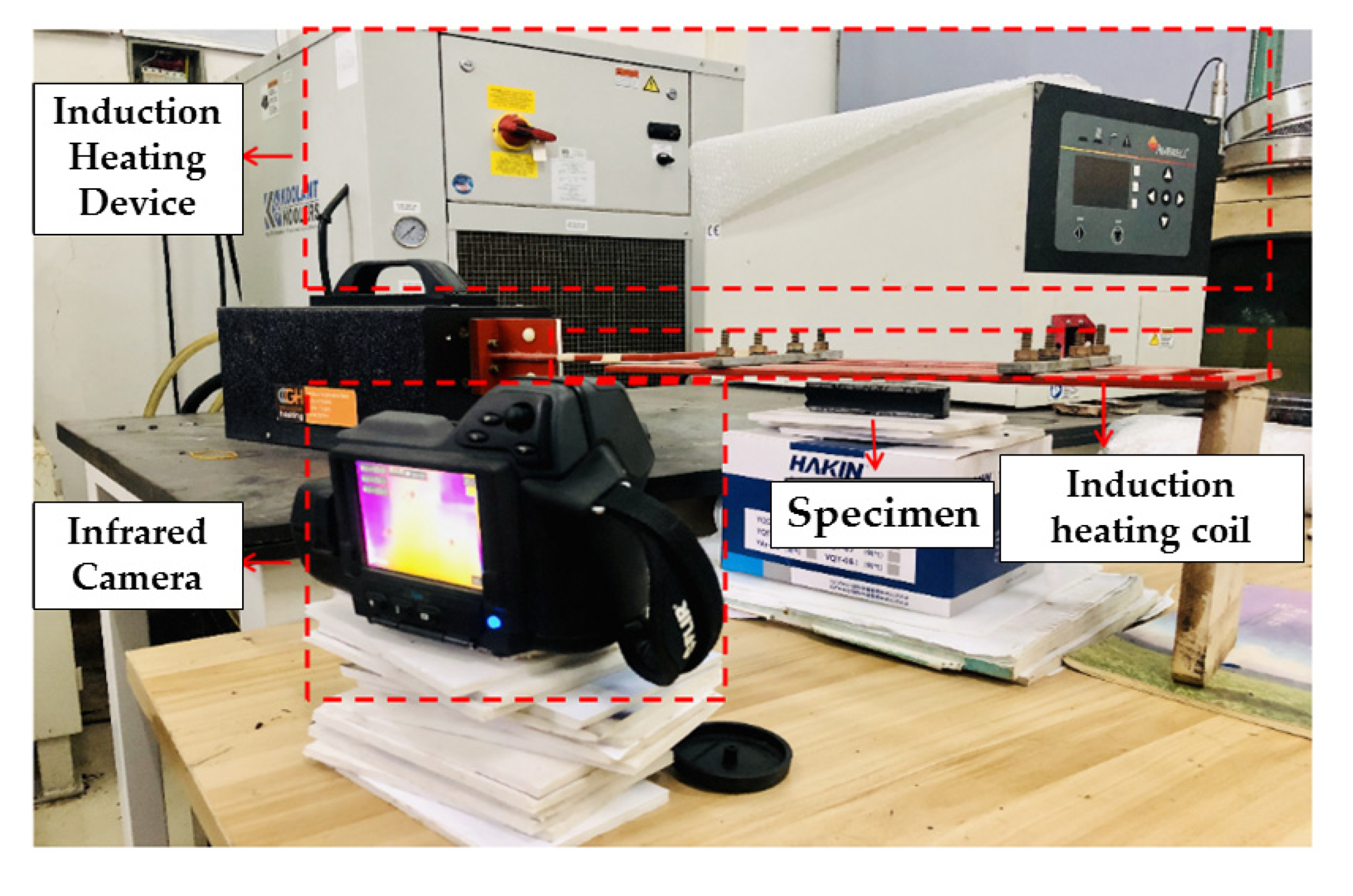
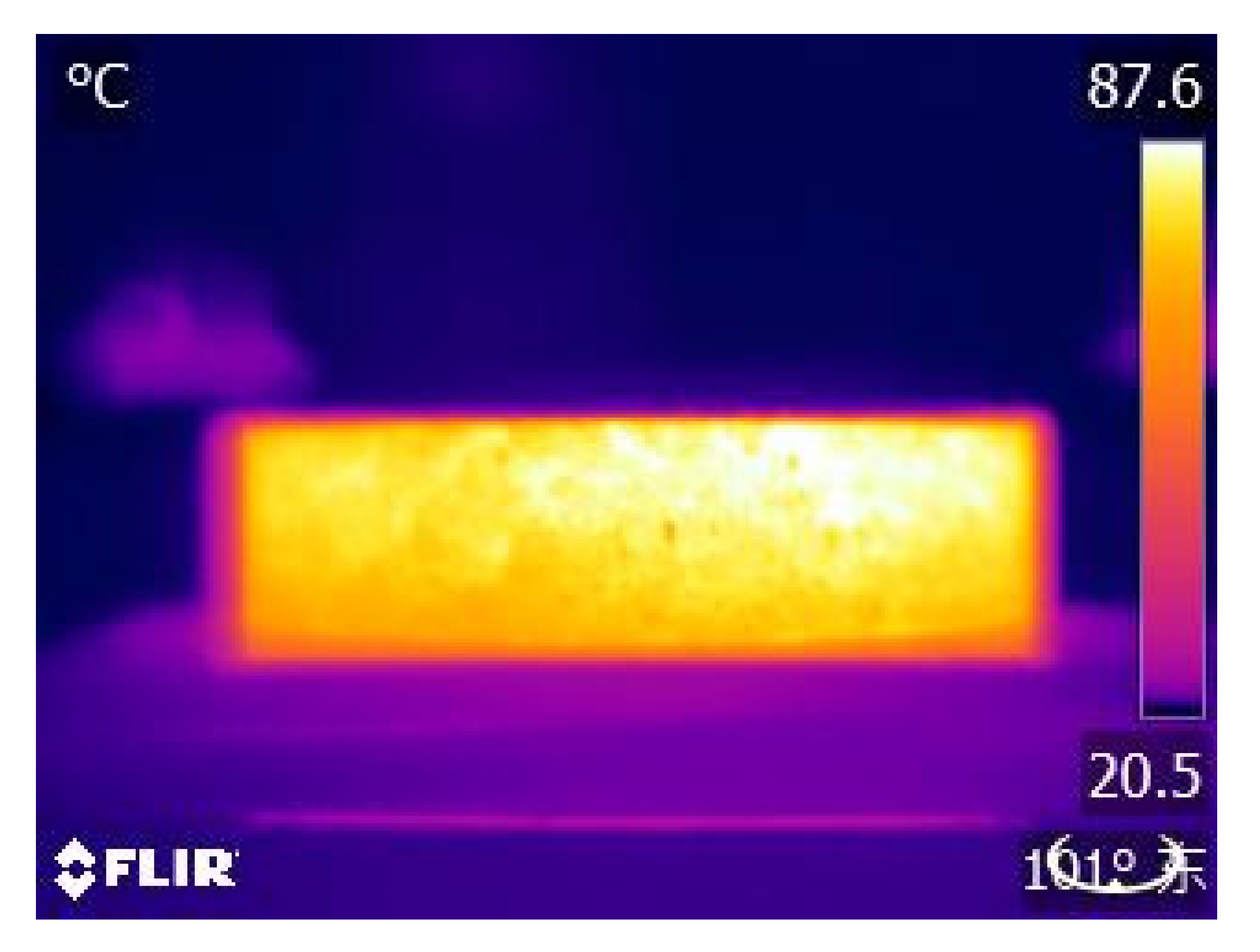
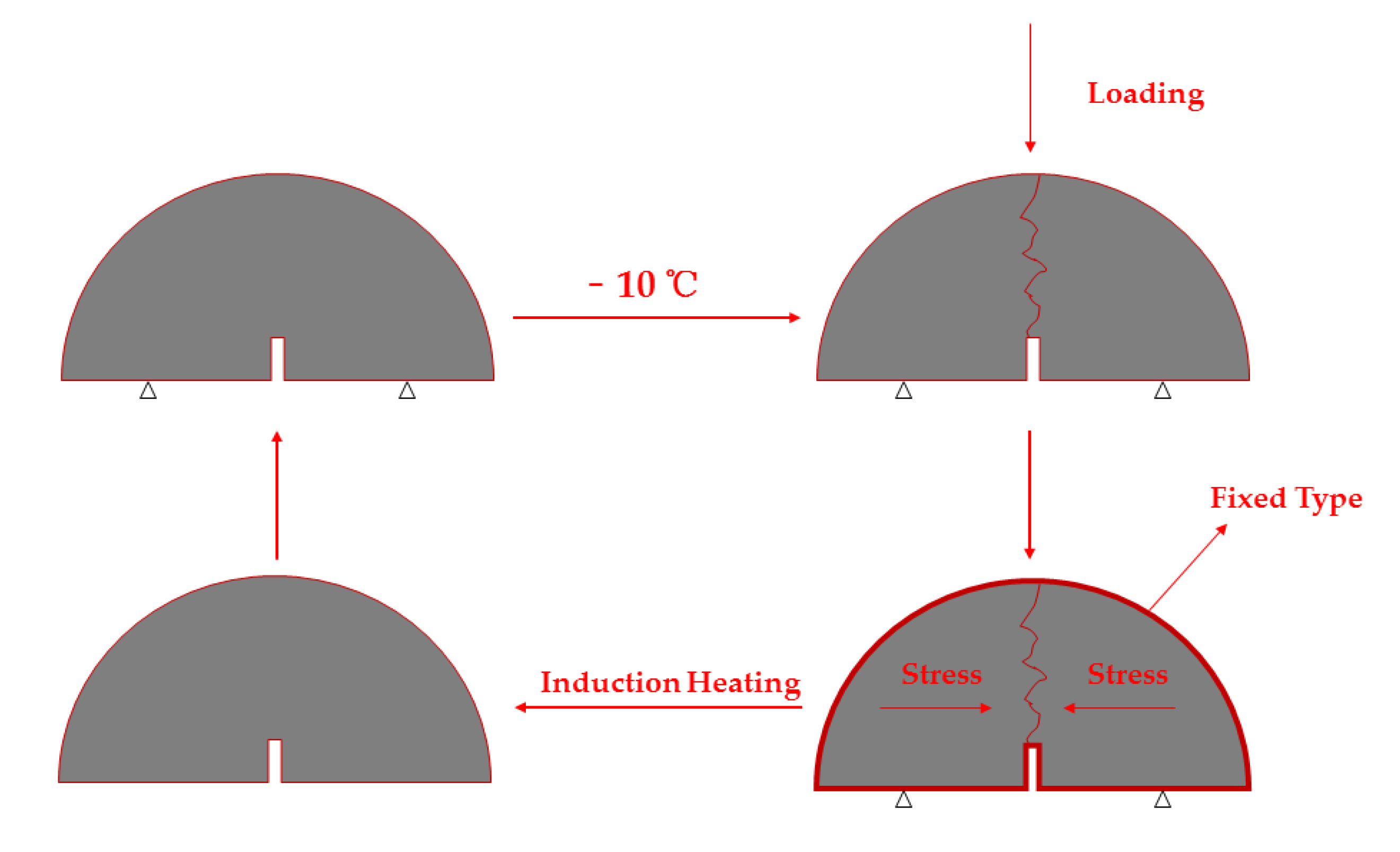



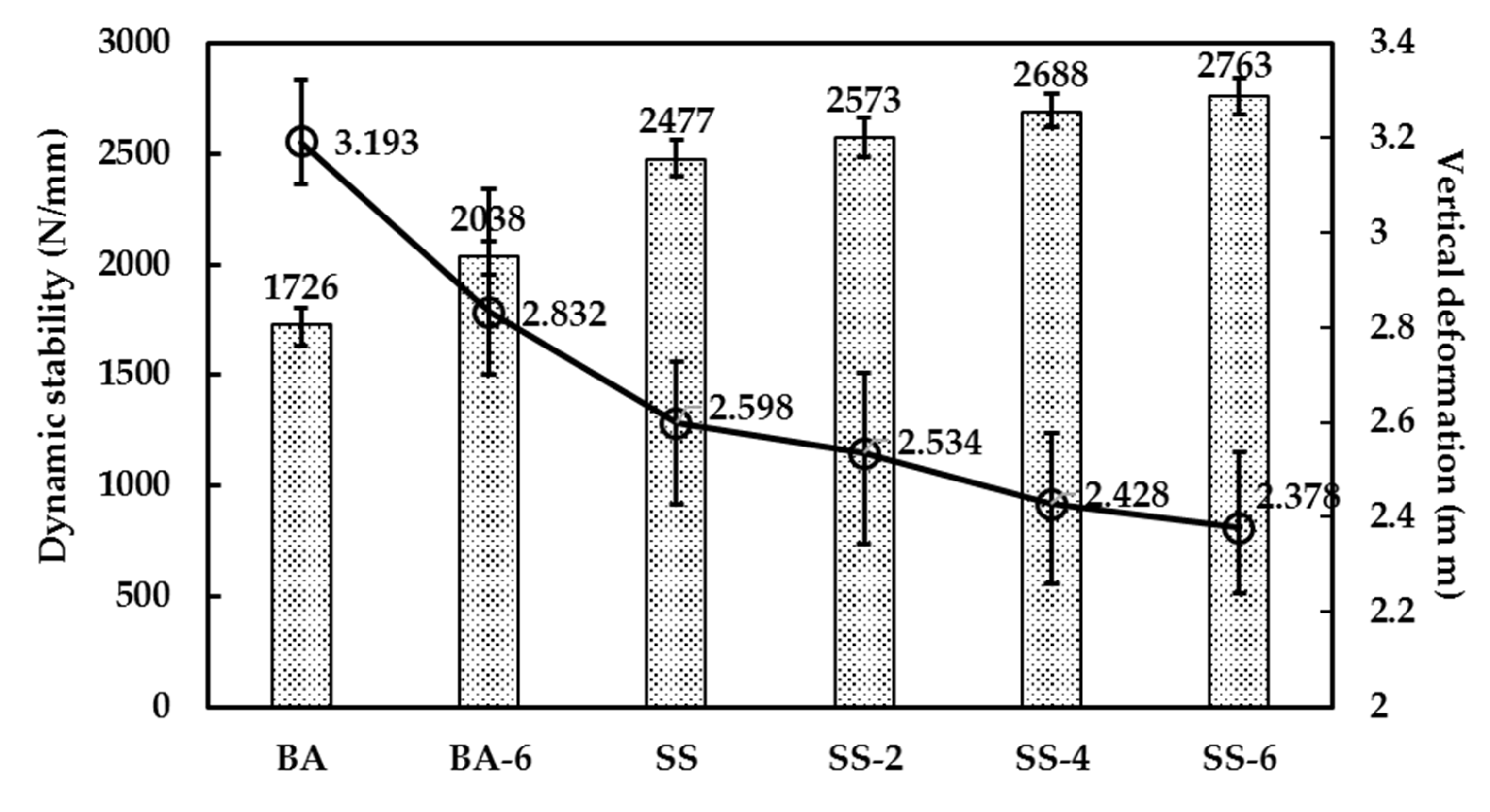
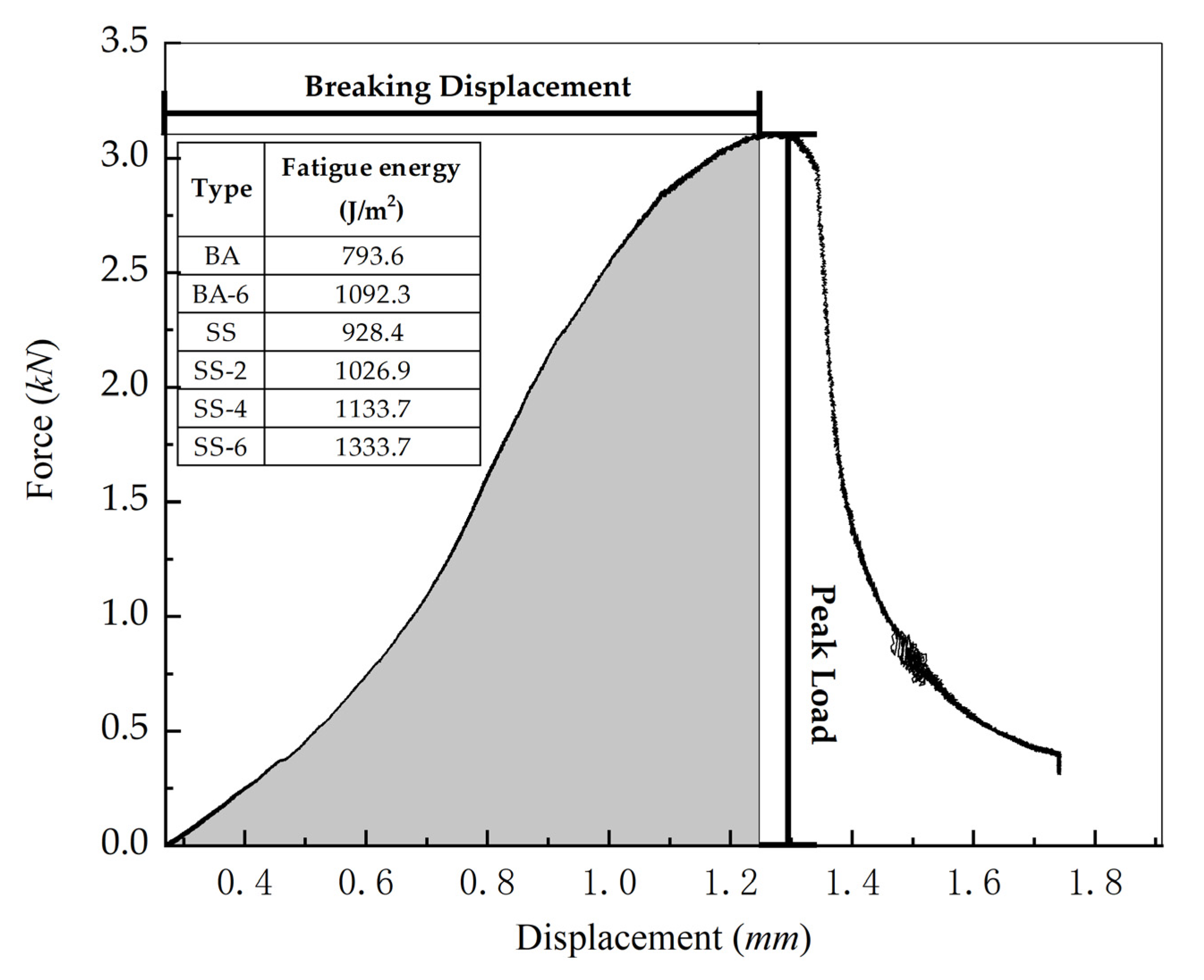
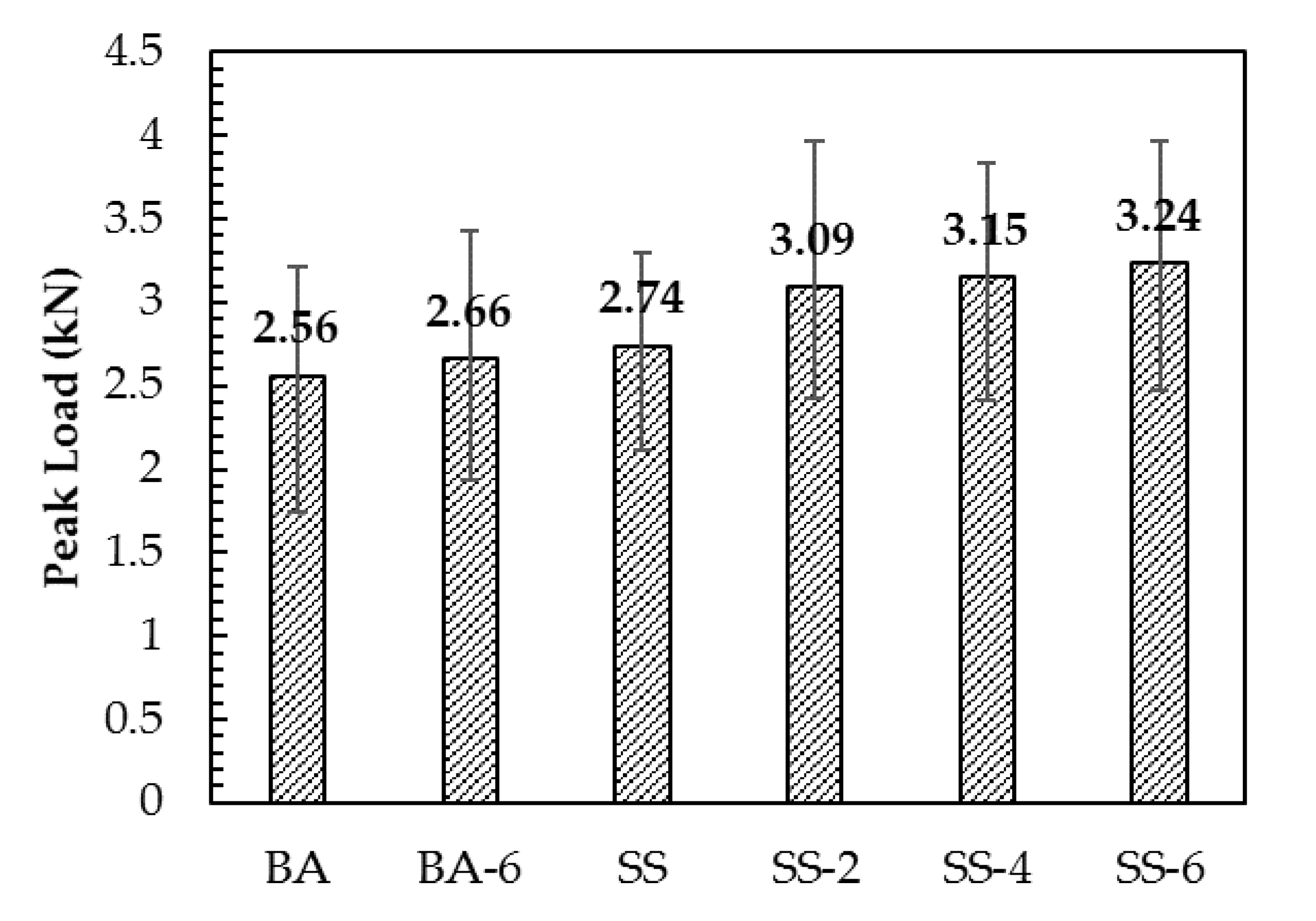
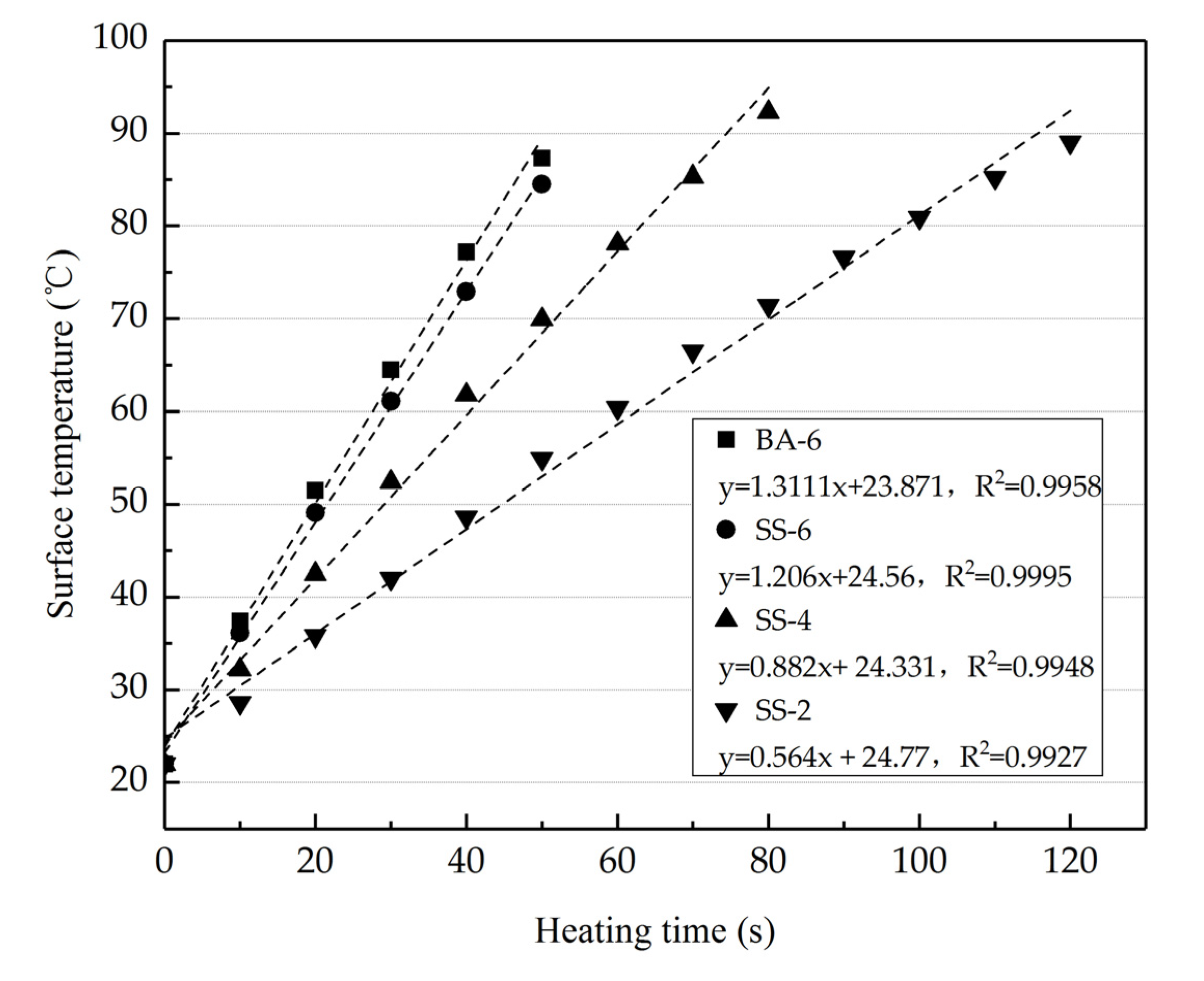

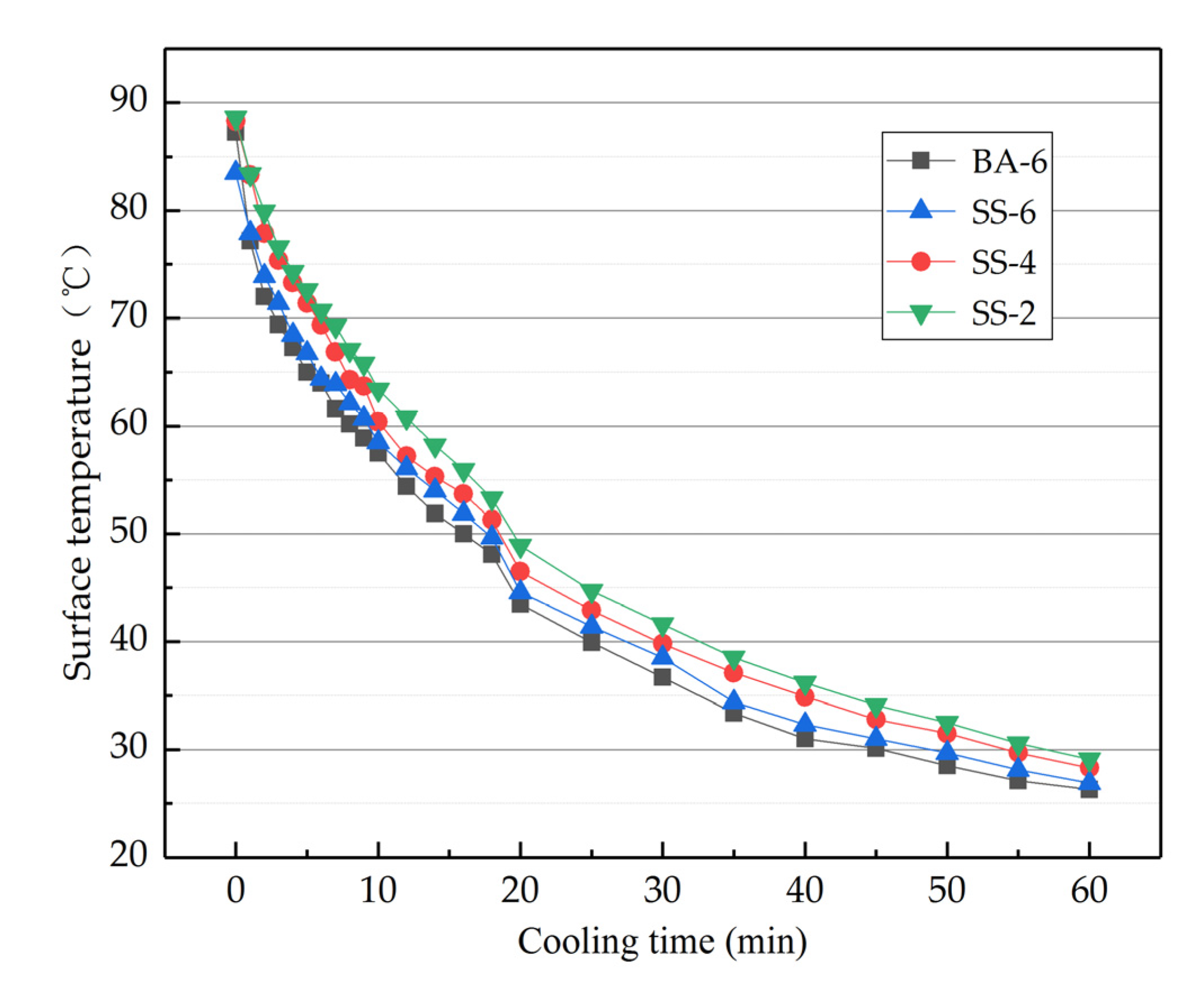
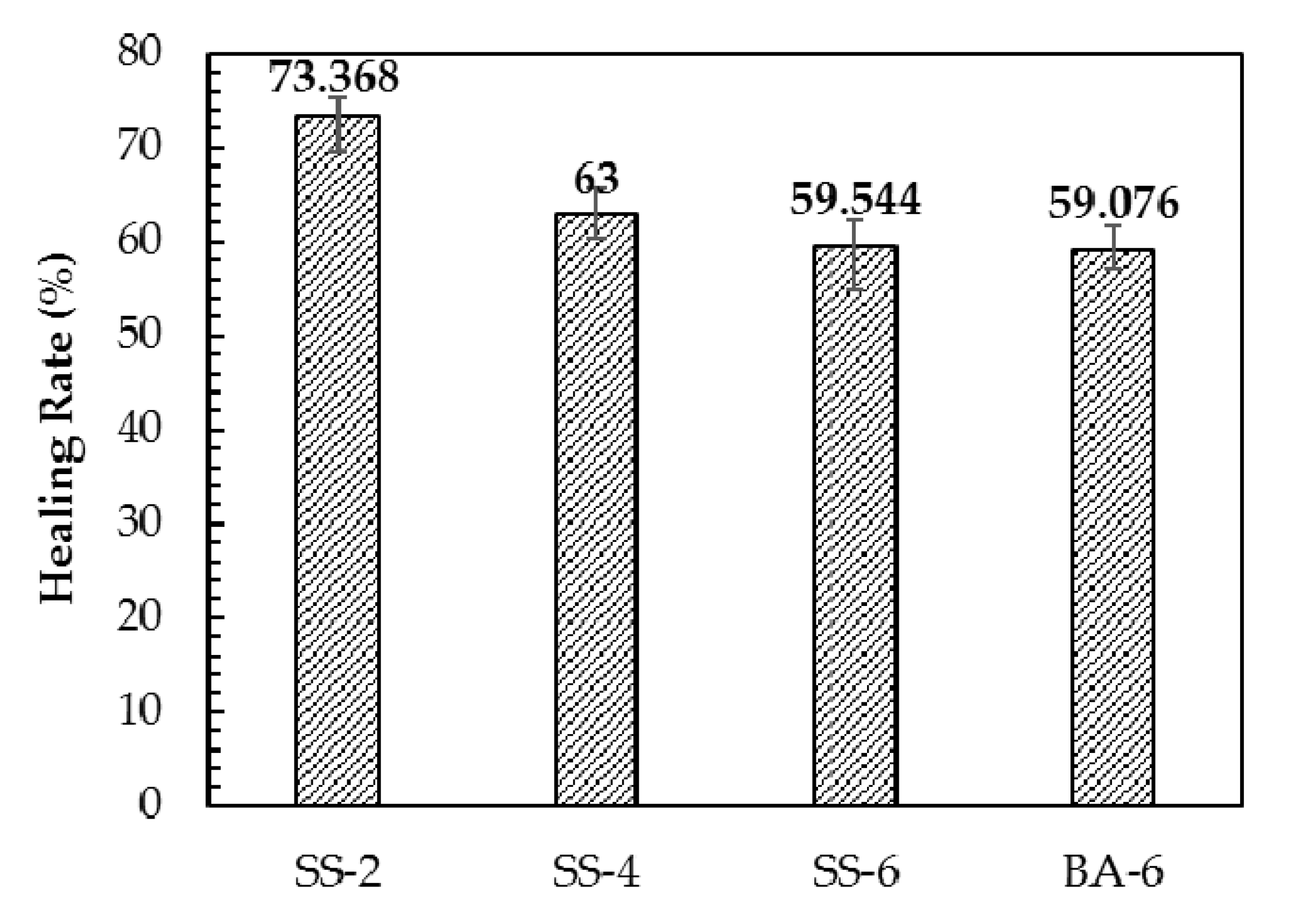

| Materials | Properties | Values | Specifications | Standard |
|---|---|---|---|---|
| Asphalt | Penetration (25 °C, 0.1 mm) | 68.9 | 60–80 | T0604-2011 |
| Ductility (15 °C, cm) | >100 | ≥40 | T0605-2011 | |
| Softening point (°C) | 49 | ≥43 | T0606-2011 | |
| Density (g/cm3) | 1.035 | - | T0603-2011 | |
| Basalt | Fine aggregates density (g/cm3) | 2.88 | ≥2.6 | T0328-2005 |
| Coarse aggregates density (g/cm3) | 2.95 | ≥2.5 | T0304-2005 |
| Materials | Properties | Values | Specifications |
|---|---|---|---|
| Steel fibers | Average length (mm) | 4.2 | - |
| Equivalent diameter (μm) | 70–130 | - | |
| Density (g/cm3) | 7.8 | - | |
| Steel slag | Fine aggregates density (g/cm3) | 3.56 | ≥2.9 |
| Coarse aggregates density (g/cm3) | 3.65 | ≥2.9 | |
| Los Angeles abrasion | 8.3 | ≤28 | |
| Crush values | 12.9 | ≤26 |
| Aggregate | Single Point Surface Area at P/Po (m2/g) | BET Surface Area (m2/g) |
|---|---|---|
| Basalt | 6.0915 | 6.3051 |
| Steel slag | 10.1707 | 10.5559 |
| Type | RT1 (MPa) | RT2 (MPa) | TSR (%) |
|---|---|---|---|
| BA | 1.121 | 0.963 | 85.9 |
| BA-6 | 1.203 | 1.082 | 89.9 |
| SS | 1.249 | 1.022 | 81.8 |
| SS-2 | 1.293 | 1.077 | 83.3 |
| SS-4 | 1.343 | 1.138 | 84.7 |
| SS-6 | 1.421 | 1.225 | 86.2 |
| Mixture Type | Thermal Conductivity (W/mK) | Thermal Diffusivity (mm2/s) | Specific Heat (MJ/m3K) |
|---|---|---|---|
| BA | 1.08 | 1.35 | 0.80 |
| BA-6 | 1.11 | 1.45 | 0.77 |
| SS | 0.78 | 0.87 | 0.89 |
| SS-2 | 0.86 | 0.89 | 0.97 |
| SS-4 | 0.91 | 0.97 | 0.94 |
| SS-6 | 0.94 | 1.04 | 0.91 |
© 2020 by the authors. Licensee MDPI, Basel, Switzerland. This article is an open access article distributed under the terms and conditions of the Creative Commons Attribution (CC BY) license (http://creativecommons.org/licenses/by/4.0/).
Share and Cite
Xu, H.; Wu, S.; Li, H.; Zhao, Y.; Lv, Y. Study on Recycling of Steel Slags Used as Coarse and Fine Aggregates in Induction Healing Asphalt Concretes. Materials 2020, 13, 889. https://doi.org/10.3390/ma13040889
Xu H, Wu S, Li H, Zhao Y, Lv Y. Study on Recycling of Steel Slags Used as Coarse and Fine Aggregates in Induction Healing Asphalt Concretes. Materials. 2020; 13(4):889. https://doi.org/10.3390/ma13040889
Chicago/Turabian StyleXu, Haiqin, Shaopeng Wu, Hechuan Li, Yuechao Zhao, and Yang Lv. 2020. "Study on Recycling of Steel Slags Used as Coarse and Fine Aggregates in Induction Healing Asphalt Concretes" Materials 13, no. 4: 889. https://doi.org/10.3390/ma13040889
APA StyleXu, H., Wu, S., Li, H., Zhao, Y., & Lv, Y. (2020). Study on Recycling of Steel Slags Used as Coarse and Fine Aggregates in Induction Healing Asphalt Concretes. Materials, 13(4), 889. https://doi.org/10.3390/ma13040889






